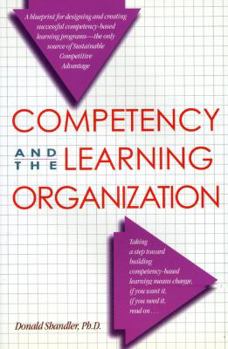Competency and the Learning Organization
Competency models have proven to be one of the most cost-effective and quickest ways to put ideas into practice. This description may be from another edition of this product.
Format:Paperback
Language:English
ISBN:1560525665
ISBN13:9781560525660
Release Date:April 2000
Publisher:Crisp Learning
Length:104 Pages
Weight:0.40 lbs.
Dimensions:0.3" x 6.0" x 9.0"
Customer Reviews
2 ratings
Competencies Condensed -- A Good Introduction
Published by Thriftbooks.com User , 17 years ago
This book is a good 100-page introduction to the use of competencies to enhance learning in organizational settings. The author overviews the nature of competencies, the creation of competency models, the design of competency-based curricula, the implementation of competency-based learning and the eventual evaluation of these efforts. The author's points are illustrated through real-world case studies of competency-based learning at the HON Company, Sears University, Kodak Latin America, the Bank of Montreal, and Myer Grace Brothers--a diverse sampling of organizational settings. The book does not focus on non-training applications of competencies, such as employee selection or job classification. This is a limitation in scope that may cause some potential readers to look elsewhere for such information. Interested readers may also choose to engage with the more in-depth sources the author has mined for information about organizational learning (Competency-Based Performance Improvement: A Strategy for Organizational Change) and evaluation of training (Evaluating Training Programs: The Four Levels). The author serves the training community well by providing a condensed presentation of these works, empowering readers to decide if they will benefit from further exploration. The author adopts Scott Parry's definition of a competency as a "...cluster of knowledge, skills and attributes...that can be improved through training and development." This restriction of competencies to the trainable matches the author's learning focus, but is not congruent with other definitions which include personal characteristics that may not be easily trainable. Because of this, the author's approach may not be useful to readers that use competencies more broadly. Many competency frameworks--such as the U.S. Office of Personnel Management's, cited in the book--include competencies based on mental abilities and personality constructs. They are regarded by psychologists as less trainable that "subject-matter domain" competencies such as Legal Knowledge or Human Resources Management. The author--and his readers--need to face this distinction in deciding how to develop--or whether it is possible to develop--specific employee competencies. Books are valuable both for the questions they answer and for the questions they raise. This book does both. It is worth stealing from your company's corporate library. Enjoy!
A beginners guide to creating a competency based learning program
Published by Thriftbooks.com User , 18 years ago
Found this book very informative. Provides steps that could be taken to create a competency based program. Includes competency creation, assessment and delivery options. Lots of great ideas.






